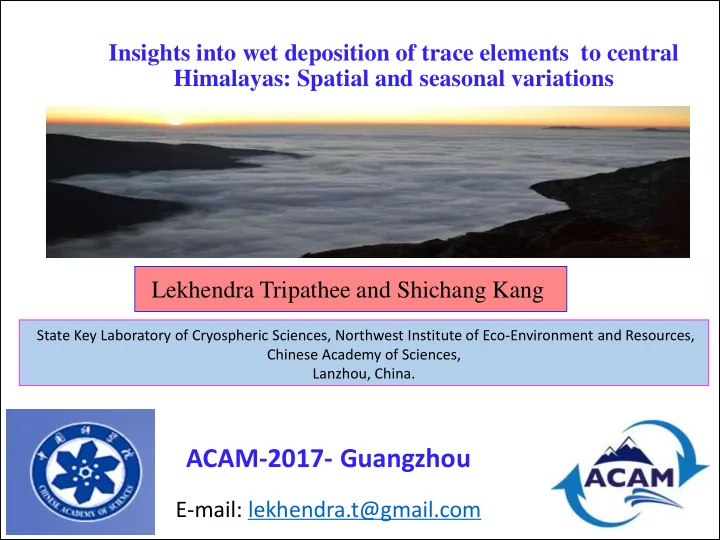

Insights into wet deposition of trace elements to central Himalayas: Spatial and seasonal variations Lekhendra Tripathee and Shichang Kang State Key Laboratory of Cryospheric Sciences, Northwest Institute of Eco-Environment and Resources, Chinese Academy of Sciences, Lanzhou, China. ACAM-2017- Guangzhou E-mail: lekhendra.t@gmail.com
So Sources and tr transport pathways of f pollu llutants in in th the envi vironment
Precipitation composition studies Why?? • Precipitation is considered as the natural pathway for removal of atmospheric pollutants • Data of the wet deposition of trace elements are useful for assessment of pollutant emission • Bioaccumulation • toxic and risk to human and the ecosystem health • persistence and can be long-range transported
Mercury??? • High toxicity, volatility • Long range transport • Long atmospheric residence • bio-accumulate in human body
Status in southern side of the central Himalayas • Lack of studies • Long term monitoring
Objectives Precipitation Composition Central Himalayas Long term Observation: Inorganic Elements and Hg • Understand the distribution, seasonality and sources of inorganic pollutants • Baseline database
Sampling sit ites Kathmandu, Dhunche, Dimsa and Gosainkunda on the southern side of central Himalayas. Urban, semi-urban and rural with different elevation transect and geographical features Stations sites, elevation and average annual rainfall Latitude Longitude Altitude Sites (˚N) (˚E) (m) Rainfall (mm) Kathmandu 27.68 85.35 1314 1445.22 Dhunche 28.11 85.30 2065 1883.92 Dimsa 28.10 85.33 3078 - Gosainkunda 28.08 85.40 4417 -
Sampling sit ites Dhunche Semi-urban Dimsa (Rural) Kathmandu (Urban) The major human activities around the Gosainkunda (Remote) Kathmandu are vehicles emission, industries, unmanaged urbanization and agricultural activities around the valley In Dimsa and Gosainkunda, the major human activities are tourism and limited agricultural activities, local emissions are only due to burning of biomass for cooking and making the houses warm.
Sampling Sit ites Tibetan Plateau 15Km Langtang National park Capital city
Laboratory analysis • Inductively coupled plasma-mass spectrometry (ICP-MS, X-7 Thermo Elemental) • Trace elements (e.g. Al, Cr, Mn, Fe, Co, Ni, Cu, Zn, Cd, and Pb) • Mercury : cold and vapor atomic fluorescence spectroscopy (CVAFS) • Tekran (Model 2600 mercury analysis system
Resu sult lts: concentratio ion of f elem lements in in Precip ipit itatio ion Element Kathmandu Dhunche Dimsa Gosainkuna N=68 N=69 N=45 N=40 Al 145.05 52.25 84.71 40.36 Cr 1.11 0.20 1.06 0.95 Mn 5.76 2.25 4.67 2.08 Fe 170.58 52.49 85.44 43.41 Co 0.69 0.38 1.18 0.79 Ni 0.49 1.02 1.03 0.47 Cu 1.35 0.87 0.92 0.45 Zn 16.91 9.78 8.40 13.15 Cd 0.071 0.061 0.018 0.01 Pb 0.981 0.908 0.589 0.357 • Higher mineral particle loading in urban site (Kathmandu) • Cd and Pb showed a trend ‘‘higher/lower in south/north’’
Se Seasonal variations of f TE TEs • Kathmandu was not clear • Local sources were dominant over the regional sources • Other three stations exhibited a clear seasonal variation
Enric ichment Factor: : Natural l cru rustal l Vs s anthropogenic ic contr trib ibutio ion The EF can be defined as: • Where X represents the element of interest • EF x is the enrichment factor of X; C x is the concentration of X; and C R • The concentration of a reference element (e.g. Al) • The average top soil composition from the Tibetan Plateau (Li et al., 2009) • Proximity of our sampling sites with the TP
Average Enri richment Factors of f Trace elem lements • non enriched elements such as (Fe, Mn; 1-10) • moderately enriched such as (Cr, Ni, Cu and Pb; 10-100) • highly enriched (Cd and Zn; >100)
EFs s vs. s. lo log Al l EF of non-crustal elements would decrease with increasing Al concentration • Fe and Mn do not show good correlations • Remaining elements have a more defined inverse relationship, indicating a source other than crustal.
Results: Mercury ry in in precipitation THg (ng L -1 ) Sites RHg/THg (%) PHg/THg (%) Kathmandu 20.6 20 59 Dhunche 10.1 26 60 Dimsa 7.7 19 80 Gosainkunda 6.5 5 63 Dhunche Kathmandu Dimsa Gosainkunda
Comparison (Concentrations and Flux) Total mercury (THg) Wan et al. (2009) Fu et al. (2010) Xu et al. (2014) Wang et al. (2014) Zhu et al. (2014) Fang et al. (2004) Seo et al. (2012) Seo et al. (2012) Keeler et al. (2006 ) Keeler et al. (2006) Guentzel et al. (2001) Hansen and Gay (2013) Hansen and Gay (2013) Sakata and Marumoto (2005) Aas and Breivik (2007) Prestbo and Gay (2009) Huang et al. (2012c) Huang et al. (2012c) Huang et al. (2013b) This work This work This work This work
Se Seasonal l vari riatio ions of f total l Mercury ry Monsoon 1 2 3 4 5 6 7 8 9 10 11 12 Months
Enric ichment of f Mercury ry in in precip ipit itatio ion
Conclusions • Elemental composition mainly controlled by regional crustal dust and anthropogenic emissions • Elements (Cr, Co, Ni, Cu, Zn, Cd, Pb and Hg) were from anthropogenic sources and Al, Fe and Mn were from crustal origin • Major anthropogenic metals had decreasing trend from urban to remote and lower to higher altitude • No clear seasonal variation at urban location • Remote sites are still ideal place to monitor background concentrations • Baseline database established • Need for more long-term spatial monitoring to better understand the long-range transport of pollutants from South Asia and other regions to Himalayas
Recommend
More recommend